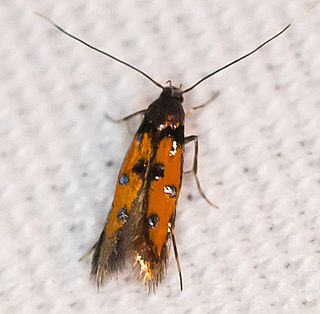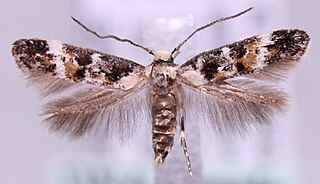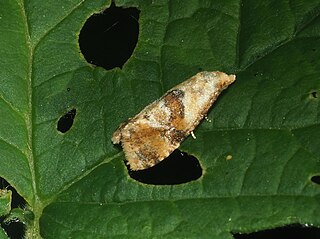
The red underwing is a moth of the family Erebidae. The species was first described by Carl Linnaeus in his 1767 12th edition of Systema Naturae.

Apatura ilia, the lesser purple emperor, is a species of butterfly native to most of Europe and east across the Palearctic. It is named for its similarity to the purple emperor butterfly.

Mythimna albipuncta, the white-point, is a moth of the family Noctuidae. The species was first described by Michael Denis and Ignaz Schiffermüller in 1775. It is distributed throughout Europe and one subspecies is found in Tunisia. It is also found in Asia Minor, Armenia, and Iran, and the northeastern United States.

The Azelinini are a tribe of geometer moths in the subfamily Ennominae, with many species in the Southern Hemisphere, particularly in South America. Several species are found in North America as well. These stocky geometer moths seem to be closely related to other robust tribes, such as the Campaeini, Ennomini, Lithinini and Nacophorini – all of which might warrant to be subsumed in the Ennomini – the genus Odontopera, and perhaps the Caberini and Colotoini. The tribe was first described by William Trowbridge Merrifield Forbes in 1948.
Bacotoma is a genus of moths in the subfamily Spilomelinae of the family Crambidae. It currently comprises 11 species, with an Oriental and Australasian distribution ranging from India and Sri Lanka over China and Southeast Asia to Australia.
Marasmianympha is a genus of moths of the grass moth family (Crambidae) described by Eugene G. Munroe in 1991. Its single species, Marasmianympha eupselias, was described by Edward Meyrick in 1929. Among the grass moths, it belongs to subfamily Spilomelinae. It is endemic to the Marquesas Islands of Polynesia, where it has been recorded on Fatu Hiva, Hiva Oa and Tahuata, but is suspected to occur on other islands as well. The holotype specimen is in the Natural History Museum, London.
Clarkeophlebia is an enigmatic and almost-unknown gelechioid moth genus. It contains a single species, Clarkeophlebia argentea, and is apparently endemic to Fatu Hiva in the Marquesas Islands of Polynesia. It was originally described as Acanthophlebia, but this name had earlier been given to a genus of prong-gilled mayflies.

Mompha epilobiella is a moth in the family Momphidae found in Europe and North America.

Chrysoclista linneella, is a moth of the family Agonoxenidae found in Europe and North America.
Epicephala spinula is a moth of the family Gracillariidae, one of the most primitive groups of ditrysian "micromoths". Within its family, it belongs to the subfamily Gracillariinae. Even though it was first scientifically studied in 1929, for many decades the specimens of this moth were mistaken for the related Australian species E. colymbetella, and their distinctness was only realized in 1986. It is found on the Marquesas Islands, where it occurs at least on Nuku Hiva, Ua Pou, and Fatu Hiva, and though little-known it is apparently not uncommon. The holotype specimen, a female, is USNM 100839.

The shy cosmet moth is a moth of the family Cosmopterigidae. It is known from all of Europe, as well as Asia, Australia and New Zealand. It is also present in North America, where it is distributed from Nova Scotia to Virginia, west to Oklahoma and north to Ontario. The habitat consists of fens and marshes.

Mompha langiella is a moth of the family Momphidae. It is found in most of Europe, except parts of the Balkan Peninsula and the Mediterranean islands.

Chrysoclista lathamella is a species of moth of the family Agonoxenidae described by Thomas Bainbrigge Fletcher in 1936. It is found in northern Europe.

Mompha lacteella is a moth in the family Momphidae found in the Palearctic including Europe.
Lepidochrysops miniata is a butterfly in the family Lycaenidae. It is found in Zambia. The habitat consists of miombo woodland.

Arethusana is a butterfly genus from the subfamily Satyrinae of the brush-footed butterfly family (Nymphalidae). It is composed of only one species, Arethusana arethusa, the false grayling.

Phalonidia lavana, or Platphalonidia lavana, is a species of moth of the family Tortricidae, the subfamily Tortricinae, and the tribe Cochylini. It has a terrestrial habitat and is found throughout North America. It does not have a Global Conservation Status Rank.

Lineodini is a tribe of the species-rich subfamily Spilomelinae in the snout moth family Crambidae.

Phalonidia udana, or the loosestrife conch, is a European species of moth of the family Tortricidae, the subfamily Tortricinae, and the tribe Cochylini. It is widely distributed in the North Palaearctic but appears to be largely rare or missing in Central Europe. Previously, it was classified under the Phalonidia manniana taxon, but a recent effort to barcode all North European Lepidoptera revealed that P. udana and P. mannania are two distinct species.
The Cabera subalba group is a monophyletic group under the genus Cabera. These moths are widely distributed in the Palaearctic, Nearctic, Neotropic and Afrotropic regions, and a few in Indo-Australian regions. However, the group is absent in Australia itself.
Content in this edit is translated from the existing German Wikipedia article at de:Elophila rivulalis; see its history for attribution.














